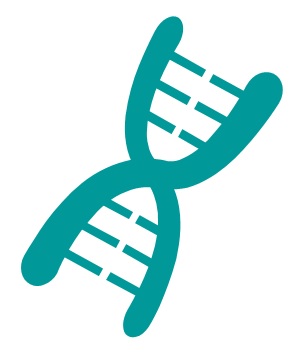[Glu2]-TRH tripeptide – pGlu-Glu-Pro-NH2 (CAS: 85541-78-2)
Thyrotropin-releasing hormone (TRH)
Thyrotropin-releasing hormone (TRH) is a tripeptide hypothalamic regulatory hormone that regulates the release of thyroid-stimulating hormone (TSH),as well as prolactin (for breasts growth and milk production during and after pregnancy).
To obtain thyrotropin-releasing hormones,6 pro-TRH peptides have first to be obtained from the larger preproTRH precursor (UniProt: P20396). These octapeptides are then cleaved between Arginine/Glutamine and Glutamine/Lysine residues to release 6 Gln-His-Pro-Gly peptides that will be enzymatically converted in pGln-His-Pro-NH2 peptides (pGln representing pyroglutamine).
After TRH maturation (1) in neurons located in the pituitary gland,the hormone will be transported along axons (2) to reach the hypophyseal portal system via exocytosis (3). Once the thyrotrophs reached,thyrotropin-releasing hormone binds TRH-receptor (4) to enable TSH synthesis and secretion that will stimulate thyroid follicular cells to produce thyroid hormones Triiodothyronine (T3) and Tetraiodothyronine (T4).
![[Glu2]-TRH_pGluGLuPro-NH2_SB-PEPTIDE scheme: TRH metabolism pathway](https://www.sb-peptide.com/image/Schema-TRH-pathway-webpage-Glu2-TRH-1024x565.jpg)
TRH implication in hypothyroidism and cholinergic neuronal activity
TRH being directly involved in TSH release,deficiency of this hormone has been found to be related to secondary hypothalamic hypothyroidism. This condition can affect all body functions,causing various symptoms of different severity from fatigue to brittle nails,cold intolerance or joint pain even.
On the contrary,even though no case of excessively high levels of TRH was observed up to now,studies showed the cholinergic effect of TRH in mouse brain. In 1991,for instance,M. G. Giovannini & al. associated TRH administration,s.c. or via local perfusion,with acetylcholine (ACh) release increase from rodents’ cortex and hippocampus,which suggested the strong stimulant action of TRH on cortical and hippocampal cholinergic pathways.
[Glu2]-TRH tripeptide applications
In the last few years,[Glu2]-TRH,or PGPA for pyroglutamyl-glutamyl-proline amide,has been widely studied due to its potential applications in science and medicine. Indeed,this synthetic peptide has been associated with a wide range of biological effects,including anti-inflammatory,antioxidant,and neuroprotective activities.
Moreover,low levels of TSH being naturally impacted by deficient production of TRH,analogs with impaired recognition by thyroliberinase,such as [Glu2]-TRH,depicted interesting features to counteract its degradation. As a matter of fact,histidine substitution by glutamic acid in TRH original sequence prevents enzymatic cleavage between the N-terminal pyroglutamyl group and the usual central histidine residue. This metabolically stable synthetic peptide significantly attenuates TRH-induced hippocampal extracellular acetylcholine release,thereby acting as a negative modulator of TRH cholinergic effect in mice brain.
SB-PEPTIDE also offers the original TRH peptide (or protirelin) for various diagnostic procedures and useful information in patients with pituitary or hypothalamic dysfunction.
Technical specification
 |
Sequence : pGluGluPro-NH2 / ZEP-NH2 |
 |
MW : 354 ,36 g/mol (C15H22N4O6) |
 |
Purity : > 95% |
 |
Counter-Ion : TFA Salts (see option TFA removal) |
 |
Delivery format : Freeze dried in propylene 2mL microtubes |
 |
Other names : TRH analog,[Glu2]-protirelin |
 |
Peptide Solubility Guideline |
 |
Bulk peptide quantities available |
Price
| Product catalog | Size | Price € HT | Price $ USD |
| SB280-5MG | 5 mg | 220 | 275 |
| SB280-25MG | 25 mg | 1100 | 1375 |
References
Brain Res Bull. 2010 Apr 29; 82(1-2): 83–86. doi: https://doi.org/10.1016/j.brainresbull.2010.02.007
[Glu2]TRH dose-dependently attenuates TRH-evoked analeptic effect in the mouse brain
Thyrotropin-releasing hormone (TRH,pGlu-His-Pro-NH2) and the structurally related [Glu2]TRH (pGlu-Glu-Pro-NH2) are endogenous peptides with a plethora of actions in the central nervous system. Many centrally-mediated effects of TRH are shared with those of [Glu2]TRH,although the involvement of different receptors are presumed. The analeptic action is the best-known TRH-related central nervous system effect. While [Glu2]TRH itself is analeptic,its co-administration with TRH into mice produced a dose-depended attenuation of TRH-evoked reversal of barbiturate-induced sleeping time. This finding is in agreement with our previous observations that [Glu2]TRH significantly attenuates TRH-induced hippocampal extracellular acetylcholine release. Taken together,[Glu2]TRH may be considered as a negative modulator for the cholinergic effect of TRH in the mouse brain.
Brain Res. 2002 May 10;935(1-2):59-64. doi: https://doi.org/10.1016/S0006-8993(02)02454-X
Role of TRH receptors as possible mediators of analeptic actions of TRH-like peptides
A large family of TRH-like peptides in the limbic region of rat brain including pGlu-Glu-Pro-NH2 (EEP),pGlu-Val-Pro-NH2 (Val2-TRH),Leu2-TRH,Phe2-TRH and Tyr2-TRH has recently been discovered. TRH (pGlu-His-Pro-NH2) has antidepressant,neuroprotective,analeptic,anticonvulsant,antiamnesic and euphoric properties,and other TRH-like peptides such as EEP exert several of these effects. A new TRH receptor (TRHR2) has been reported which is highly expressed in regions of rat brain that regulate attention and learning,arousal,sleep and processing of sensory information. The TRHR1 predominates in limbic structures involved in regulation of mood and in pituitary. This study examined the possibility that some of the newly discovered TRH-like peptides bind with high affinity to TRHR2,and that this receptor acts as the transducer for some of the CNS effects of this new class of neuropeptides. EEP,Val2-TRH and Leu2-TRH were analeptics,like TRH,but Phe2-TRH and Tyr2-TRH were not. The affinity and efficacy of TRH-like peptides for TRHR1 and TRHR2 were measured in HEK293 cells stably expressing these receptors. The IC50 values of TRH-like peptides for displacement of [3H]TRH from TRHR2 were TRH⋘(Leu2-,Phe2-TRH)<(Gln2-,Ser2-TRH)≪(Val2-,Tyr2-,Arg2-,Thr2-,and Glu2-TRH). The IC50 for Leu2-TRH was about 100 times that for TRH. When tested at the calculated IC50 values,TRH-like peptides stimulated calcium responses in cells expressing TRHR1 and TRHR2,indicating that the peptides act as weak agonists at both receptors. These results indicate that TRHR1 and TRHR2 do not mediate the behavioral effects of TRH-like peptides.
Br J Pharmacol. 1991 Feb; 102(2): 363–368. doi: https://doi.org/10.1111/j.1476-5381.1991.tb12179.x
Effect of thyrotropin releasing hormone (TRH) on acetylcholine release from different brain areas investigated by microdialysis
1) The effect of thyrotropin releasing hormone (TRH) administration upon acetylcholine (ACh) release in freely moving rats was investigated by means of transversal microdialysis coupled to h.p.l.c. TRH administered either s.c. or via local perfusion increased the ACh release from the cortex and hippocampus but not from the striatum. The increase in ACh release was maintained after 7 days of s.c. administration of TRH.
2) After s.c. injection of the neuropeptide,the increase in ACh release was dose-dependent and reached a maximum at 40 min after administration. The maximal percentage increases were 18,52,66 and 89% at doses of 1,2.5,5 and 10 mg kg−1 and 35,48 and 54% at doses of 2.5,5 and 10 mg kg−1 in the cortex and hippocampus,respectively. The effect of TRH was dependent on neuronal activity since it was completely inhibited by perfusion with tetrodotoxin (TTX),5 × 10−7 m.
3) Perfusion with TRH,2.5 μg μl−1,caused 198% and 150% increase in ACh release 60 and 80 min after the beginning of the perfusion in the cortex and hippocampus,respectively. After this initial peak,a 100% increase in ACh release persisted throughout the perfusion.
4) Systemic TRH administration was followed by marked hyperactivity and stereotyped behaviour that showed a time course shorter than that of the increase in ACh release.
5) These findings demonstrate that TRH exerts a strong stimulant action on cortical and hippocampal cholinergic pathways.
